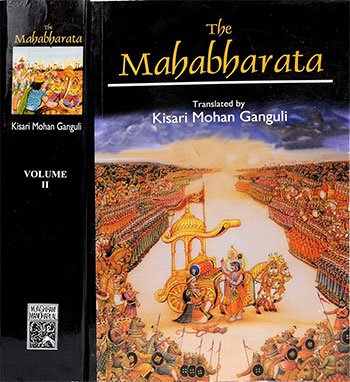Section C - Narada Describes Hiranyapura: City of Danavas and Daityas
Book index: Mahabharata (English)
This page contains a summary of the Mahabharata Section C including examples of moral lessons in daily life. The Maha-Bharata is one of the largest epics ever written containing roughly 100,000 Sanskrit verses. It deals with the legendary history of ancient India and contains a large number of interwoven tales.
Short summary of the chapter:
Narada and Matali visit Hiranyapura, a city belonging to the Daityas and Danavas, known for its illusions and the invincible Asuras who reside there. The city is beautifully adorned with mansions made of silver, gold, gems, and jewels, and the residences are built with exquisite architectural beauty. Narada points out the stunning recreational retreats, beds, utensils, and seats of the Daityas, as well as their magical trees that yield fruits and flowers at will. Matali hesitates to form an alliance with the Daityas due to the eternal enmity between the gods and Danavas, and suggests seeking a suitable bridegroom elsewhere.
Narada and Matali explore the luxurious residences and amenities of Hiranyapura, where the Kalakhanjas, Yatudhanas, and Nivatakavacas dwell, displaying formidable strength, speed, and powers of illusion. The Daityas' palatial homes shine with the radiance of various precious gems and minerals, and their surroundings are adorned with lapis lazuli, corals, and exquisite decorations. Despite the allure of the city, Matali is reluctant to engage with the enemies of the gods and prefers to avoid any potential conflicts or alliances with the Daityas. He suggests moving on to a different location in search of a suitable bridegroom.
Narada highlights the splendor and grandeur of Hiranyapura's architecture, landscapes, and magical features, such as self-moving trees that bear various fruits and flowers, offering a glimpse into the opulent lifestyle of the Daityas and their advanced civilization. The city's exquisite edifices, crafted from precious materials like Arkasphatika, Vajrasara, Padmaragas, and bright marble, evoke a sense of wonder and admiration for their beauty. Matali remains firm in his decision to avoid entanglements with the Daityas, emphasizing the need to uphold peace and harmony between the celestial beings and their adversaries.
As they continue their exploration, Narada and Matali witness the magnificence of Hiranyapura and the incredible powers and possessions of its inhabitants, including the invincible Asuras who dwell there. The city's majestic hills, flowing fountains, and magical trees add to its enchanting allure, while the Daityas' opulent lifestyle and sophisticated creations leave a lasting impression on the visitors. Despite the temptation of the city's riches and wonders, Matali stays true to his principles and refrains from forming any alliances with the enemies of the gods, opting to seek a bridegroom elsewhere to avoid potential conflicts.
In conclusion, Narada and Matali's visit to Hiranyapura offers a glimpse into the captivating world of the Daityas and their extraordinary city, showcasing the wealth, power, and beauty that define their civilization. While the city's allure is undeniable, Matali's reluctance to engage with the Daityas reflects his commitment to maintaining peace and harmony between the celestial beings and their adversaries, highlighting the importance of diplomacy and caution in dealing with potential conflicts and alliances in the divine realms. Ultimately, their journey serves as a testament to the eternal struggle between good and evil, and the need to navigate these complex dynamics with wisdom and discernment.
Full English translation:
This page is merely a summary which is automatically generated. If you are looking for authentic sources such as the Sanskrit text or the Full English translation of Mahabharata Section C - Narada Describes Hiranyapura: City of Danavas and Daityas, have a look at the following articles:
Section C, online text
English translation by Kisari Mohan Ganguli.
Read this and other chapters online.
Mahabharata (English Summary)
by Kisari Mohan Ganguli | ISBN-10: 8121505933
Buy the latest edition:
FAQ of Mahabharata, Section C:
What kind of city is Hiranyapura and who dwells there?
Hiranyapura is a city of illusions built by the Danavas, inhabited by powerful Asuras and Rakshasas like Kalakhanjas and Nivatakavacas, who are skilled in battle and illusion.
Why did Matali refuse to seek an alliance with the Danavas in Hiranyapura?
Matali, being a celestial charioteer, did not want to make an alliance with enemies of the gods. He did not want to create conflicts and preferred to avoid searching among the Danavas.
Daily life: Narada Describes Hiranyapura: City of Danavas and Daityas:
The story tells us about the majestic city of Hiranyapura, home to various powerful beings with extraordinary abilities, showcasing the results of collaboration and the marvels achievable through skilled craftsmanship. This narrative encourages us to appreciate the power of collective effort and creativity in achieving great feats. It also touches on the themes of conflict and the importance of choosing alliances wisely. We learn that despite the allure of extraordinary capabilities and achievements, it is essential to remain true to our values and avoid alliances that conflict with our principles.
In daily life, this can be translated into working collaboratively towards common goals, valuing everyone’s unique contributions, and creating something greater together. It reminds us to carefully consider our associations and commitments, ensuring they align with our ethics and values. By fostering environments of cooperation and maintaining our integrity, we can achieve outstanding results without compromising what we stand for. Essentially, the story inspires us to combine our talents and efforts with others while navigating our relationships and alliances thoughtfully.
